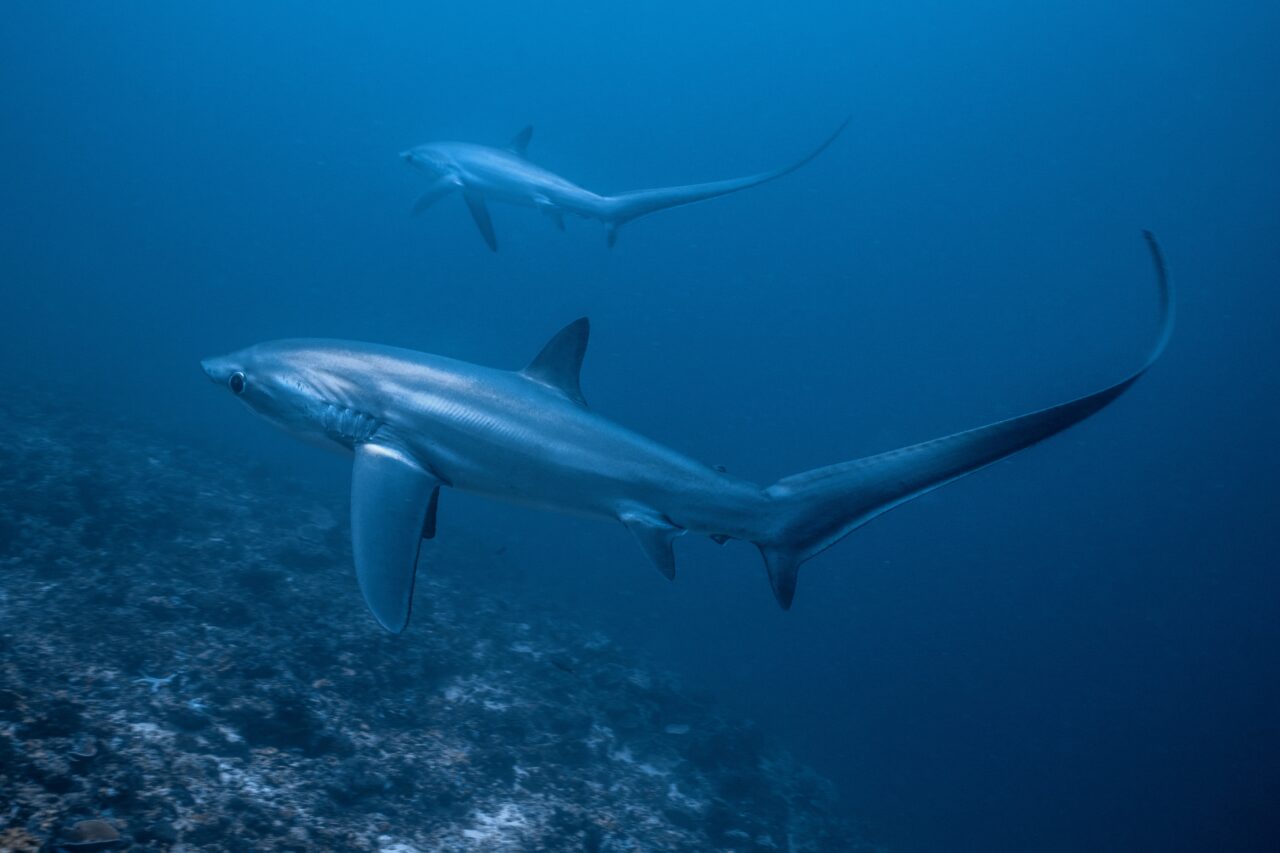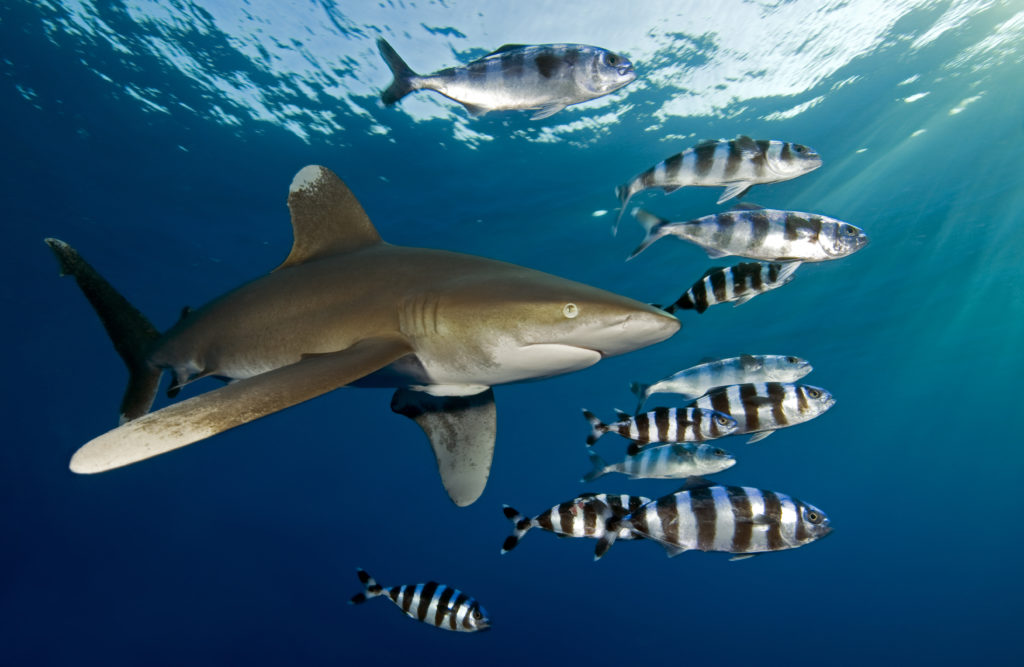
Our ocean is home to a myriad of beautiful and awe-inspiring creatures. With the asset of scuba diving; we can immerse ourselves in their world and witness them up close.
From the huge and mighty to the tiny and cute; from the weird and wonderful to the graceful and inspiring; the sheer diversity of animals living in the seas is truly mind boggling.
Some scuba divers are blown away by the likes of sharks, rays and dolphins; others are fascinated by macro critters such as nudibranch, pygmy frogfish and seahorses.
No animal is “better” than the other. All hold a special and unique place within the underwater ecosystem.
In this article, we’ll look at ten awesome marine animals you can see whilst scuba diving.
1) Oceanic Whitetip Shark
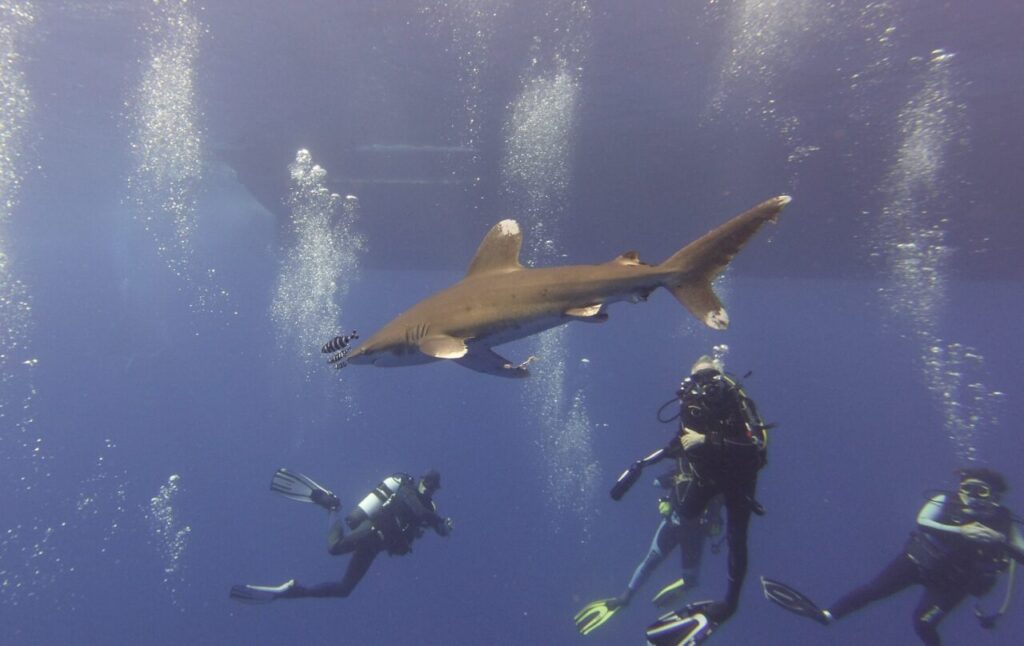
These guys are truly badass! A powerful apex-predator that grows up to 13 feet (4 meters) long, the Oceanic Whitetip Shark (Carcharhinus Longimanus) inhabits tropical and sub-tropical waters. An open-water shark, it is renowned for it’s ability to cover immense distances of water in search of food, typically cruising just a few feet beneath the water’s surface.
Perhaps the most fascinating thing about the Oceanic Whitetip Shark is the boldness and confidence that it displays. It is extremely curious of scuba diver’s – usually swimming directly up to them with intent and purpose.
It’s therefore important that diver’s have been correctly briefed about how to behave around this shark; when approached one must adopt a vertical position, maintain eye contact and not swim away or turn their back on it so as not to convince the Oceanic Whitetip that they are prey. Following these guidelines ensures a safe interaction.
Although the Oceanic Whitetip was once highly common, their numbers are estimated to have fallen by as much as 97.7% since the 1960’s due to overfishing; both for shark fin soup and as bycatch. Conservation efforts are currently underway to preserve them. Being an apex-predator, the Oceanic Whitetip has a highly important role in maintaining ocean ecosystems.
I first saw an Oceanic Whitetip shark at the dive site “Elphinstone” whilst on a Red Sea Liveaboard. This is one of the best dive sites in the world to see this remarkable species, especially between December – February. As soon as I hit the water, it swam right up to within a few feet of me as if to say “whadup”! before drifting past and being swallowed back up into the blue.
2) Flamboyant Cuttlefish
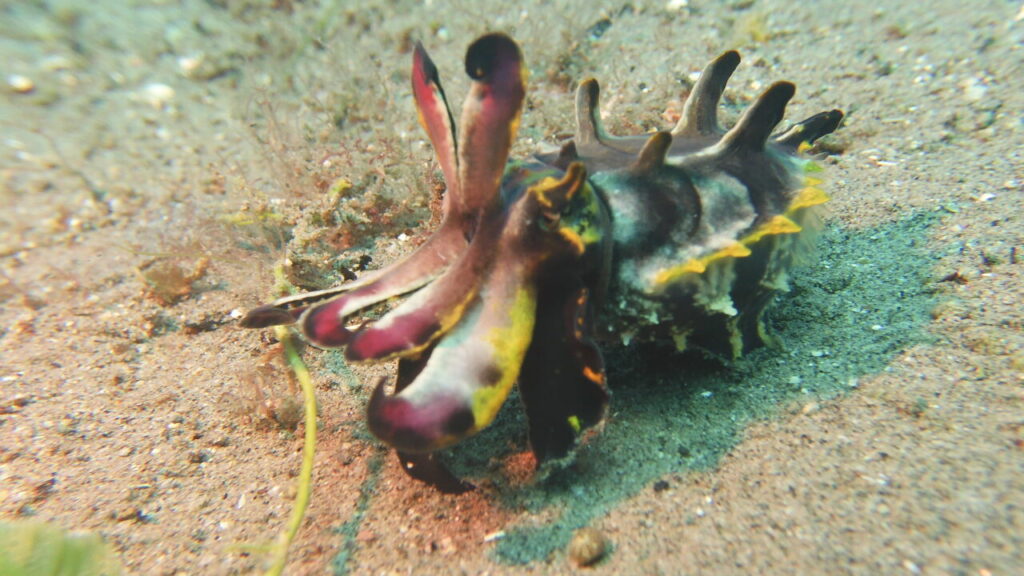
If you were to take an LSD trip and place it in organic form you’d have a flamboyant cuttlefish (Metasepia Pfefferi)! These small and awesome cephalopods are found in tropical waters around the Indo-Pacific region. They are masters of disguise; possessing the ability to change not only the colour but also the texture of their skin!
In resting form, a Flamboyant Cuttlefish is typically yellow, purple and grey; these vivid colours are a warning to predators that the Flamboyant Cuttlefish is highly toxic.
When needed, it can change the colour and texture of its skin to perfectly match its surroundings. I have witnessed one not only change it’s colour to the exact same brown hue of the dead plant hubris it was hiding against but even create small bumps and ripples to rise up on it’s previously smooth skin; perfectly matching the texture of the dead vegetation!
It’s fascinating to watch how they crawl along the seabed; doing so with a dance-like movement in which they seemingly change colour, pulses of bright shades flashing along their bodies in rhythm to their movements. Colour changing is used not only for camouflage but also as a form of communication and courtship between individuals.
At 2 – 3 inches (5 – 8 cm) long, Flamboyant Cuttlefish are one of the smaller animals on this list but are perhaps the most surreal. One of the best places I’ve ever dived for seeing them is the Dauin / Dumaguete region of the Philippines where I saw three individuals on just two dives! Here, they can be seen year round but are most common from October – December.
3) Manta Rays
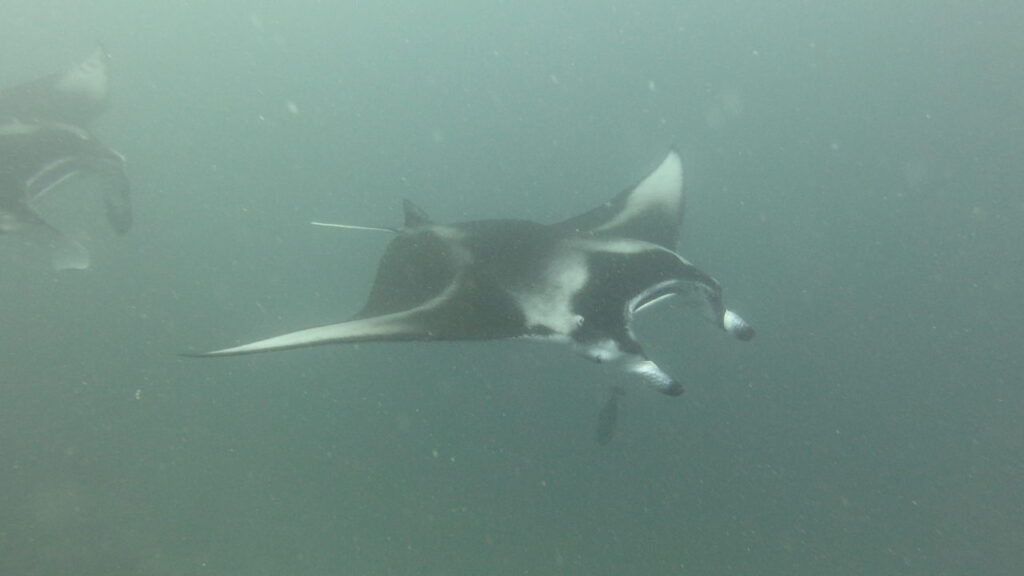
Of all the marine creatures I’ve had the honour to dive with, manta rays are perhaps the most ethereal and dream-like. These gentle filter-feeders are characterised by distinctly flat bodies and elongated cephalic fins which look very much like wings; combined with the creatures’ smooth and graceful movements; this gives the impression that they are flying underwater.
With the largest brain-to-body ratio of any fish in the ocean, manta rays exhibit high levels of intelligence; being able to recognise themselves in the mirror, displaying distinct personalities and performing graceful flips and somersaults seemingly for the sheer thrill of it. They’re also known for their curious nature around divers, often swimming right up to us.
Few folk realise this, but there’s actually two types of manta rays: reef manta rays which measure 10 – 12 feet (3 – 4 meters) wide and oceanic aka giant manta rays which measure up to 23 feet (7 meters) wide! Scuba divers are more likely to see reef mantas as they tend to stay in one location; whereas oceanic mantas are highly nomadic and live in deeper, open-waters.
Found in warm and temperate waters around the world, these social beings are often observed in groups ranging from 4 to 50 individuals. Although they are primarily filter feeders (meaning their diet consists mostly of plankton), recent studies have shown that they also prey on small fish and squid at greater depths.
I’ve dived with manta rays several times – I saw a few at Isla del Cano of Costa Rica where they’re present from December – March, however the best place for mantas I’ve dived was the Maldives where on a liveaboard we saw them on pretty much one dive out of every three! You can easily see mantas year round at the Maldives.
4) Banded Sea Krait
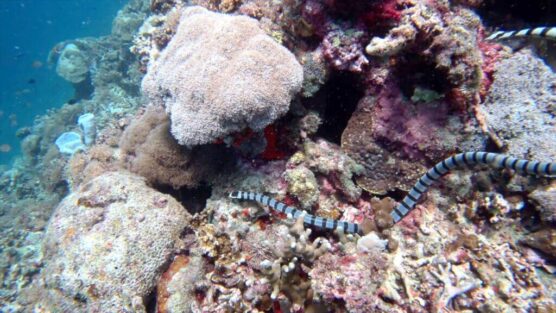
Just because Mosasaurs went extinct millions of years ago, doesn’t mean reptiles don’t still have a hold on the ocean!
Easily recognisable from the black bands around it’s vivid white or yellow body, the Banded Sea Krait (aka Yellow Lipped Sea Krait), is a beautiful and highly venomous sea snake that is widely distributed around the warm and tropical waters of the Indo-Pacific region.
It has evolved to be truly amphibious; with lungs to breathe air and a specialised gland to excrete excess salt allowing it to venture on to land. With it’s flat body and paddle-like tail it is an excellent swimmer, preying on small fish and eels which it paralyses with it’s venomous fangs before swallowing whole.
Banded Sea Krait posses superb navigation skills, returning to the same rocky shorelines year after year to breed. Eggs are laid on land and when the young hatch out they quickly return to sea.
Although highly venomous, with one adult having enough venom to kill ten humans, Banded Sea Krait are pretty docile and unlikely to bite unless immensely stressed. This means divers can get get pretty close – although you must obviously still have a healthy dose of respect and maintain a few feet distance – and never touch (same as for all marine life)!
Divers can see banded sea kraits in many part of Southeast Asia such as Thailand, Indonesia and the Philippines. I have witnessed it them all of these locations, however the place I saw the most was Moalboal where they can be seen year-round.
5) Green Sea Turtle
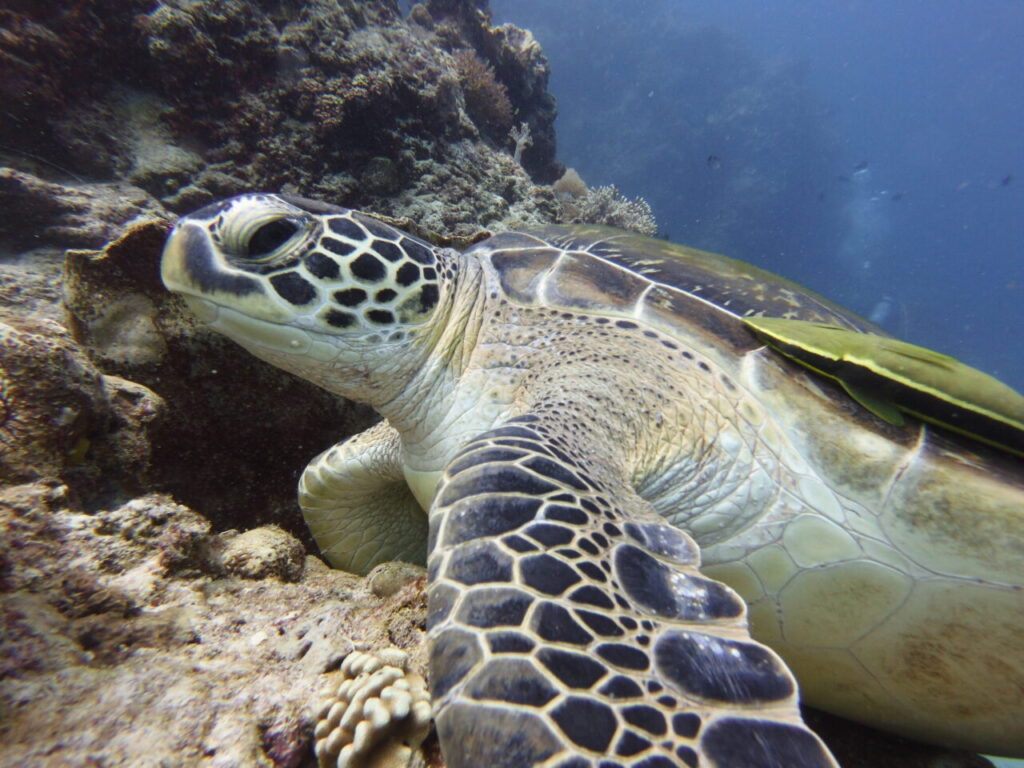
“Grab a shell dude”! even before this immortal line from the otherwise highly over-rated Finding Nemo movie came out, turtles have been popular worldwide for their charismatic, calm demeanour and beautiful appearance.
There are seven species of sea turtle but one of the most common is the green sea turtle (Chelonia mydas) which is the only one to be herbivorous; whereas other sea turtle species consume coral and jellyfish, green sea turtles exist on a diet of seagrass and algae; which contribute to the green colouration of their fat.
Their jaws are adapted to tearing vegetation and by grazing on seagrass they actually play a very important role in preventing it from overgrowing and smothering marine habitats. They are one of the largest species of sea turtles, able to reach lengths of up to 5 feet (1.5 meters) and weighing up to 700 pounds (317 kg).
Every year, green sea turtles migrate insane distance to return to their natal beaches to mate whereupon the female lays hundreds of eggs and buries them in the sand. Life starts rough for the baby turtles; as soon as they hatch they must make a mad dash for the sea, many of them picked off by predators such as birds, crabs and mammals along the way.
Green sea turtles are distributed worldwide – primarily in tropical and subtropical regions of the Atlantic, Pacific and Indian Oceans but also the Mediterranean. I’ve dived with them all over – from Costa Rica to Panama and from Thailand to the Philippines but perhaps the place I saw more than anywhere else was Siquijor where they can be seen year-round.
6) Pelagic Thresher Shark
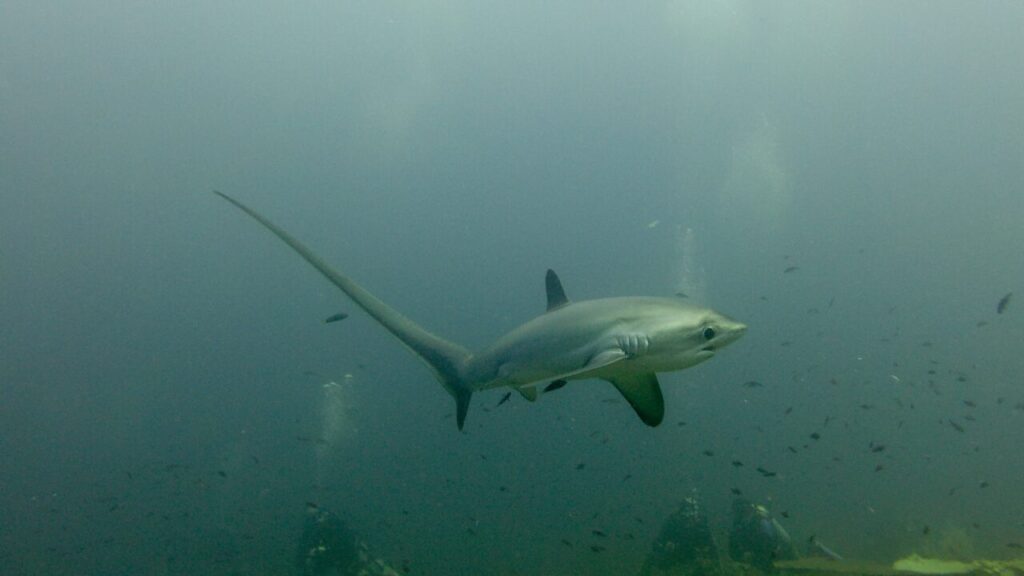
A unique and elusive species, the Pelagic Thresher Shark (Alopia Pelagicus) is characterised by its extremely long tail which can be the length of its entire body and is used to whip and stun prey such as small fish and squid.
As it’s name suggests, the pelagic thresher shark is an open-water species; inhabiting tropical and sub-tropical waters way offshore and sometimes undertaking extensive migrations.
Adults usually grow up to 12 feet (3.7 meters) long; however the largest ever recorded specimen was a whopping 25ft (7.6 meters)! With tiny mouths and small teeth, these sharks are harmless to humans and are highly unlikely to attack.
However, although shy and easily spooked, they’re also curious of divers and will often swim closer; especially if you rub your fingers together and slowly wave your hand in a circular motion whilst otherwise remaining still; which is how I got one to come within just a few feet of me!
You can see thresher sharks in a variety of locations including the Red Sea, Southeast Asia and parts of Australia…but probably the only place in the world you’re practically guaranteed to see one is the tiny island of Malapascua off the north tip of Cebu. Here, divers have a 90+ % chance of seeing thresher sharks at the dive site Kinad Shoal… all year round!
7) Pygmy Seahorse

Dropping the scale right back down to the minuscule, Pygmy Seahorses are among the smallest seahorses in the world at just 1 to 1.5 inches (2.5 – 3.8 cm) long when fully grown.
These cute little dudes have a unique appearance with bulbous heads and skin covered in small protuberances that allow them to seamlessly blend in against their favourite habitat; sea fans where they spend their entire lives; sometimes within a territory no bigger than a cubic foot.
They are mainly found in tropical waters of the Western Pacific Ocean; spanning across the Philippines, Indonesia and Australia, generally among coral reefs at depths of 16 – 131 ft (5 to 40 meters).
As with all species of seahorse, pygmy seahorses are monogamous and it is the male that carries the fertilised eggs in a specialised pouch until they hatch; releasing fully-formed minataure seahorses into the water.
Due to their tiny size and elusive nature, Pygmy Seahorses were only discovered in the 1960’s and they continue to be a challenge to study to this day, meaning much about them remains a mystery – however they are a keystone indicator species for the overall health of coral reefs.
I first saw Pygmy Seahorses when diving Gato Island on a day trip from Malapascua – however they were so tiny that without an underwater camera specialised for tiny macro subjects I wasn’t able to photography one, hence the shutterstock image!
8) Bull Shark
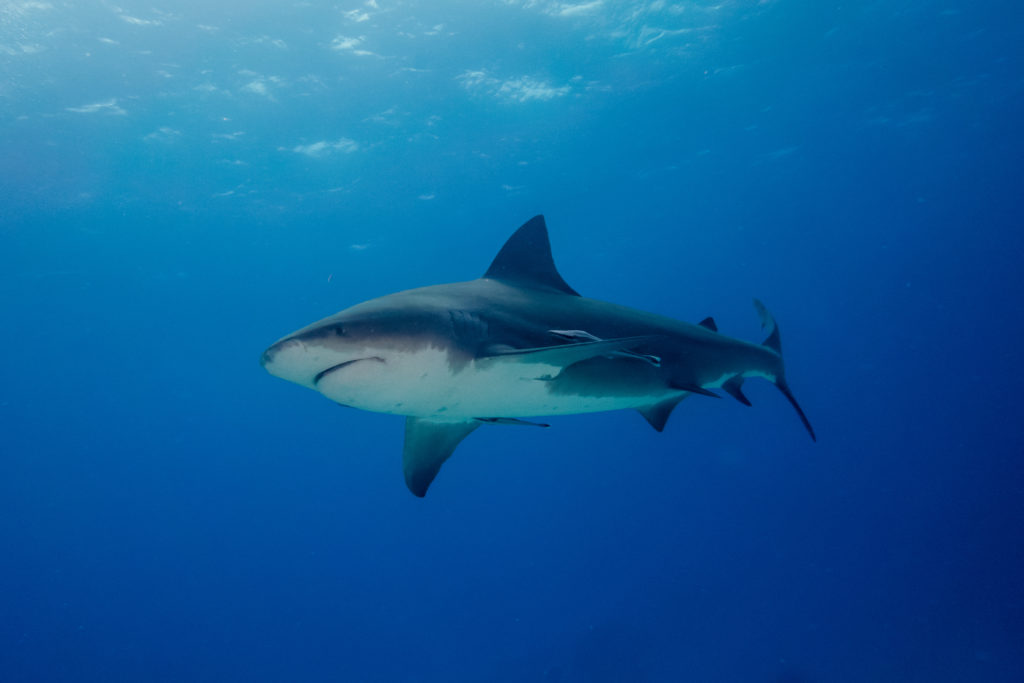
Yes, it’s another shark because I am totally shark-obsessed! This time we’re looking at the mighty bull shark; a living hulk of muscle that despite being smaller than a Great White Shark, actually has a more powerful bite. And even though they are smaller; they’re still pretty big at up to 12 ft / 4 m long.
A unique trait of bull sharks is their high tolerance of a range of salinities allowing them to venture far up rivers and even into freshwater lakes, with some people referring to them as the “river shark”. Subsequently it is one of the most widely distributed shark species in the world, being found in warm coastal and freshwater regions all over.
Bull sharks are apex predators feeding on a huge range of prey items including fish, rays, other sharks, marine mammals and even birds. They often hunt in murky water with low visibility, relying on their nose to locate prey. Once prey is located, the bull shark will burst towards it in an underwater sprint, tear a huge chunk of flesh out – then repeat until prey is dead.
Bull sharks are considered to be an aggressive species, responsible for over 100 attacks on humans and possibly behind many other un-verified attacks. However, they’re unlikely to attack un-panicked divers below the surface.
Or at least, I didn’t get attacked by any when I dived with them at the Bat Islands which from May – October is one of the best places in the world to dive with these mighty, ferocious and awe inspiring top predators.
9) Nudibranch
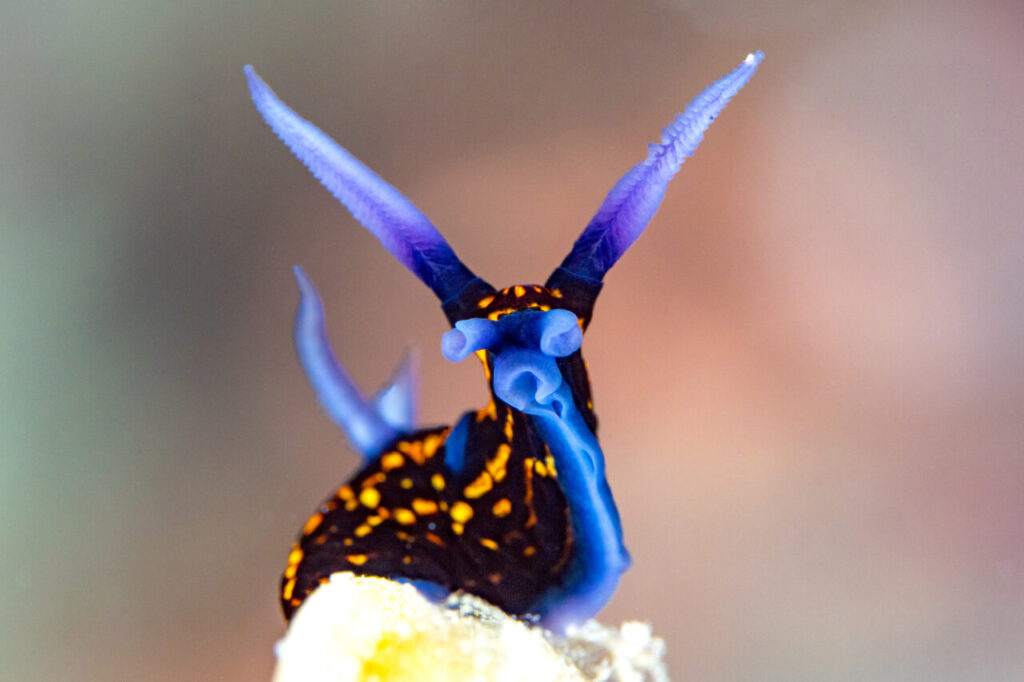
Ah the nudibranch – being able to spot one of these colourful gastropod mollusks without the assistance of a dive guide is something of a right of passage for scuba divers!
These often brightly coloured gastropod mollusks come in an immense range of colours, patterns, sizes and shapes; being found throughout the world from shallow tropical reefs to cold waters and deep sea habitats. Many divers become totally nudibranch-obsessed and set out to witness and photograph as many different types as possible!
Nudibranch occupy a range of niches throughout the marine ecosystem – some are carnivores, feeding on coral, sponge or even other nudibranch, whereas some are herbivores. A few of the carnivorous species can even incorporate the stinging cells from their preys stinging tentacles and use them for their own defence.
Although the two stalk-like appendages at the front appear to be eyes, these are actually Rhinophores: sensory organs used to smell and taste the nudibranch’s surroundings. The eyes are very simple and can only detect light and dark; appearing as two tiny dots between the rhinophores. The feathery appendages located halfway along their upper-bodies are gills shaped into brachial tubes.
I’ve witnessed all manner of nudibranch in my dives; from ghostly white, temperate water species at Killary Fjord to all manner of different species in the Philippines; especially around Bohol.
10) Bottlenose Dolphin
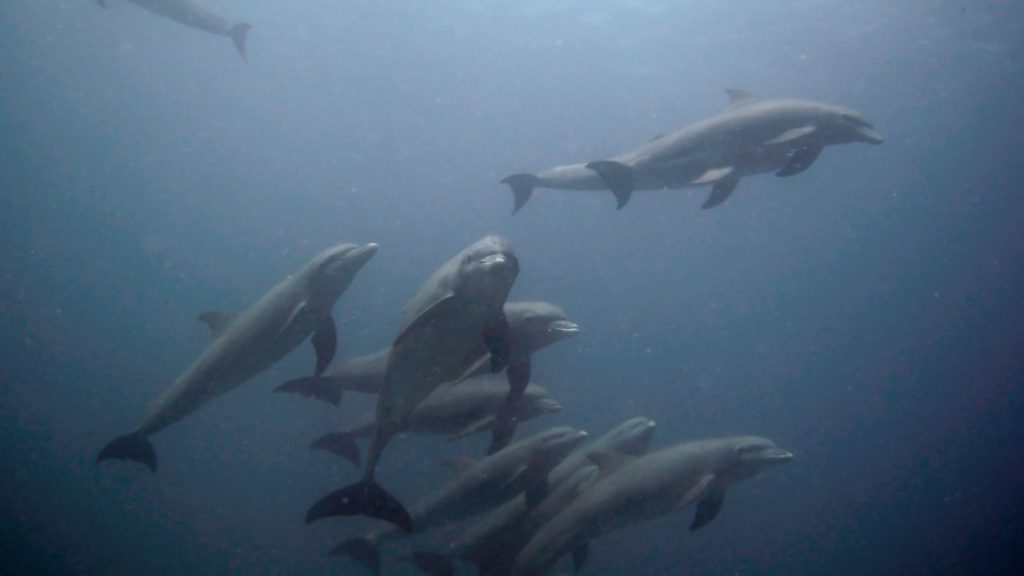
Let’s finish with an all-time favourite – dolphins! There are 42 known species of dolphin but here I’m going to specifically talk about one of the most common species: bottlenose dolphins. which are found in tropical and temperate waters worldwide.
Highly intelligent, social and charismatic, these marine mammals (cetaceans) are easily recognisable by their sleek, streamlined bodies, prominent beaks and “smiling” appearance.
They’re famous for their complex echolocation and communication abilities; producing an impressive variety of clicks, whistles and squeaks which they use to talk with one another, navigate and locate prey. They are also incredibly playful and can regularly be seen leaping out of the water, playing games and even getting high off pufferfish.
Hunting cooperatively, these spectacularly intelligent beings feed mainly on fish, squid and crustaceans. Highly sociable, they live in pods of up to several dozen members with complex social hierarchies and strong bonds between individuals.
The best place I’ve been for diving with Bottlenose Dolphins is the Corn Islands of Nicaragua (which is famous for year-round dolphin encounters), where I came face to face with a pod of eleven individuals; who circled around me several times, clicking and whistling merrily as they did – to this day it was one of the best diving experiences I’ve ever had.
Diving Squad DEBRIEFING:
And thus we do conclude this page on ten awesome marine animals that you can see whilst scuba diving – of course the ocean is a bloody huge place and there are many other fascinating marine species that you can encounter within it. I’ve only just scratched the water’s surface on this one…I’ll definitely have to follow this up with a part 2!
There’s really no such thing as a dull marine animal – some may seem more beautiful, mysterious or epic than others; but each one has it’s own special place within the marine ecosystem and deserves respect and awe…from the mightiest whale to the humblest sparrow-fish. Ok, I made that up, there’s no such thing as a sparrow fish. But you get the idea….
Finally, here’s a few tips to see your favourite marine animal on a dive:
- Research where in the world it can be seen! Some marine animals are only found in specific places. And even when there is a long list of places a marine animal can be seen, those places where it is likely to be seen may be far fewer. You don’t wanna travel half way round the world to see something only to realise it’s only found on the half you came from!
- After this, find out if the animal is seasonal – that is, is it only possible (or likely) to see it during a few certain months of the year?
- Once you’ve chosen a time and location to go looking for your desired marine animal, do read up on the kind of dive conditions that are likely to be experienced there. Some marine animals such as Oceanic Whitetip and Bull Sharks are only found at dive sites that usually experience strong currents; thus only being suitable for advanced open water divers
- Always, always, always (!) respect marine life – don’t get too close, never touch and remember to follow the instructions of your local guide.
- By all means take an underwater camera to capture the experience – but don’t get so sucked into taking mediocre GoPro photos that you miss witnessing the creature with your own two eyes. A well-recalled memory is worth a thousand generic photos.
Well that’s all for now guys. Hope you enjoyed reading this article as much as I did writing it! Do you have an awesome marine animal encounter of your own you’d like to share? Shoot us a message on the Contact Page! Peace! Adios!! Chow for now.
